
The Lyon astronomical clock (French : Horloge astronomique de Lyon) is a seventeenth-century astronomical clock in Lyon Cathedral. [1]

The Lyon astronomical clock (French : Horloge astronomique de Lyon) is a seventeenth-century astronomical clock in Lyon Cathedral. [1]
The 9 m (30 ft) tall clock is installed in the cathedral of Lyon. An astrolabe indicates the date and position of the Moon, Sun, and Earth, as well as the stars. The first documentary evidence of an astronomical clock in the cathedral is from 1383 [2] but this was destroyed in 1562. In 1661 it was reconstructed by Guillaume Nourrisson. During the French Revolution, all royal insignia was removed. The last restoration in 1954 reset the clock's perpetual calendar of 66 years. It will be accurate until 2019. [3]
The central tower octagon supports several automated figures. After the angel on the left turns the hourglass, an angel on the right keeps the time for the three angels who strike bells to sound the hymn of Saint Jean-Baptiste. The Virgin Mary kneels in a chapel, and turns to the Angel Gabriel as he opens the chapel door, while a dove descends, representing the Holy Spirit. A Swiss Guard rotates around the dome. Movement stops at the sounding of the hour.
In a western niche, a statue rotates at midnight. On Sunday, it is Jesus resurrected; Monday: his death; Tuesday: St. John the Baptist; Wednesday: St. Stephen (patron saint of the ancient basilica) holding the palm of martyrs; Thursday: a child with chalice and host; Friday: a child with the symbols of crucifixion; on Saturday: the Virgin Mary. [2]
The clock was vandalized by an Iranian man in 2013, who claimed that "the magnificence of the clock prevented the faithful from concentrating on prayer." It is currently being repaired and is scheduled to begin operation again some time in 2024. [4] [5] [6]

Chartres Cathedral, also known as the Cathedral of Our Lady of Chartres, is a Catholic cathedral in Chartres, France, about 80 km southwest of Paris, and is the seat of the Bishop of Chartres. Mostly constructed between 1194 and 1220, it stands on the site of at least five cathedrals that have occupied the site since the Diocese of Chartres was formed as an episcopal see in the 4th century. It is one of the best-known and most influential examples of High Gothic and Classic Gothic architecture, It stands on Romanesque basements, while its north spire is more recent (1507–1513) and is built in the more ornate Flamboyant style.
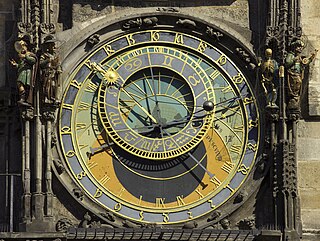
An astronomical clock, horologium, or orloj is a clock with special mechanisms and dials to display astronomical information, such as the relative positions of the Sun, Moon, zodiacal constellations, and sometimes major planets.
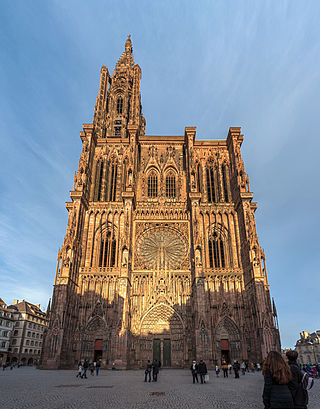
Strasbourg Cathedral or the Cathedral of Our Lady of Strasbourg, also known as Strasbourg Minster, is a Catholic cathedral in Strasbourg, Alsace, France. Although considerable parts of it are still in Romanesque architecture, it is widely considered to be among the finest examples of Rayonnant Gothic architecture. Architect Erwin von Steinbach is credited for major contributions from 1277 to his death in 1318, and beyond through his son Johannes von Steinbach, and his grandson Gerlach von Steinbach, who succeeded him as chief architects. The Steinbachs’ plans for the completion of the cathedral were not followed through by the chief architects who took over after them, and instead of the originally envisioned two spires, a single, octagonal tower with an elongated, octagonal crowning was built on the northern side of the west facade by master Ulrich Ensingen and his successor, Johannes Hültz. The construction of the cathedral, which had started in the year 1015 and had been relaunched in 1190, was finished in 1439.

The Cathedral Basilica of Our Lady of Amiens, or simply Amiens Cathedral, is a Catholic cathedral. The cathedral is the seat of the Bishop of Amiens. It is situated on a slight ridge overlooking the River Somme in Amiens, the administrative capital of the Picardy region of France, some 120 kilometres north of Paris.

Rouen Cathedral is a Catholic church in Rouen, Normandy, France. It is the see of the Archbishop of Rouen, Primate of Normandy. It is famous for its three towers, each in a different style. The cathedral, built and rebuilt over a period of more than eight hundred years, has features from Early Gothic to late Flamboyant and Renaissance architecture. It also has a place in art history as the subject of a series of impressionist paintings by Claude Monet, and in architecture history as from 1876 to 1880, it was the tallest building in the world.

Bourges Cathedral is a Roman Catholic church located in Bourges, France. The cathedral is dedicated to Saint Stephen and is the seat of the Archbishop of Bourges. Built atop an earlier Romanesque church from 1195 until 1230, it is largely in the High Gothic or Classic Gothic architectural style and was constructed at about the same time as Chartres Cathedral. The cathedral is particularly known for the great size and unity of its interior, the sculptural decoration of its portals, and the large collection of 13th century stained glass windows. Owing to its quintessential Gothic architecture, the cathedral was declared a UNESCO World Heritage Site in 1992.

Lyon Cathedral is a Roman Catholic church located on Place Saint-Jean in central Lyon, France. The cathedral is dedicated to Saint John the Baptist, and is the seat of the Archbishop of Lyon. Begun in 1180 on the ruins of a 6th-century church, it was completed in 1476. Despite its long construction time, it has a relatively consistent architectural style. In 1998, the building, along with other historic sites in the center of Lyon, was inscribed on the UNESCO World Heritage List.
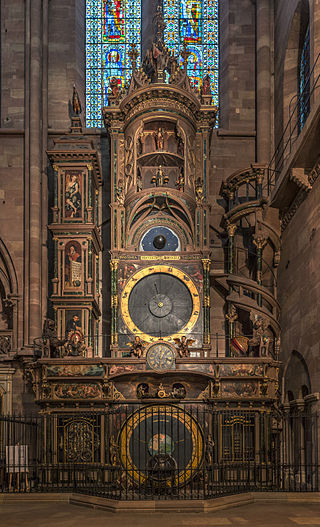
The Strasbourg astronomical clock is located in the Cathédrale Notre-Dame of Strasbourg, Alsace, France. It is the third clock on that spot and dates from the time of the first French possession of the city (1681–1870). The first clock had been built in the 14th century and the second in the 16th century when Strasbourg was a Free imperial city of the Holy Roman Empire.
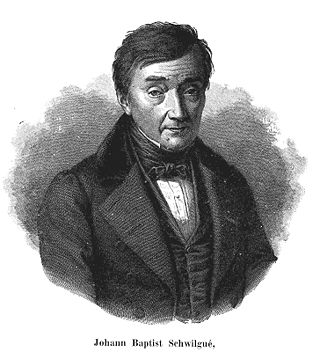
Jean-Baptiste Schwilgué (1776–1856) was the author of the third astronomical clock of Strasbourg Cathedral, built between 1838 and 1843 . In 1844 Schwilgué, together with his son Charles, patented a key-driven calculating machine, which seems to be the third key-driven machine in the world, after that of Luigi Torchi (1834) and James White (1822).

Aix Cathedral in Aix-en-Provence in southern France is a Roman Catholic church and the seat of the Archbishop of Aix-en-Provence and Arles. The cathedral is built on the site of the 1st-century Roman forum of Aix. Built and re-built from the 12th until the 19th century, it includes Romanesque, Gothic and Neo-Gothic elements, as well as Roman columns and parts of the baptistery from a 6th-century Christian church. It is a national monument of France.

Quimper Cathedral, formally the Cathedral of Saint Corentin, is a Roman Catholic cathedral and national monument of Brittany in France. It is located in the town of Quimper and is the seat of the Diocese of Quimper and Léon. Saint Corentin was its first bishop.

Saint-Brieuc Cathedral is a Roman Catholic church located in the town of Saint-Brieuc, Brittany, France, and dedicated to Saint Stephen.

Nice Cathedral is a Catholic cathedral located in the city of Nice in southern France.
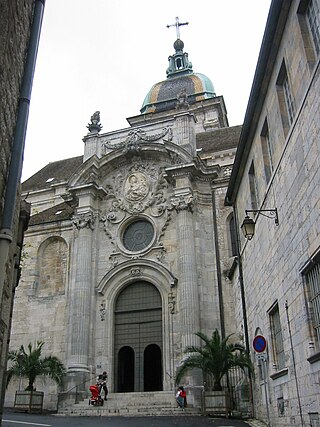
Besançon Cathedral is a Roman Catholic church dedicated to Saint John located in the city of Besançon, France. It is the seat of the Archbishop of Besançon.

Dol-de-Bretagne Cathedral is a Roman Catholic church located in Dol-de-Bretagne. The cathedral is dedicated to Saint Samson, one of the founding saints of Brittany. It was formerly the seat of the Archbishop of Dol, one of the nine ancient bishoprics of Brittany. The cathedral suffered badly from the excesses of the French Revolution, becoming successively a "Temple de la Raison", then a stable, then a warehouse. Revolutionaries caused considerable damage and many treasures were lost. When it eventually returned to being a house of worship, its role as a bishopric was abolished by the Concordat of 1801 when the Dol diocese was merged into the Dioceses of Rennes and Saint-Malo. The Concordat of 1801 was an agreement between Napoleon and Pope Pius VII, signed on 15 July 1801 in Paris, which sought national reconciliation between revolutionaries and Catholics. The Concordat was abrogated by the law of 1905 on the separation of church and state.

The Besançon astronomical clock is housed in Besançon Cathedral. Auguste-Lucien Vérité of Beauvais designed and built Besançon's present astronomical clock, between 1858 and 1863. It replaced an earlier clock that Bernardin had constructed in the 1850s that proved unsatisfactory. Besançon's clock differs from those in Strasbourg, Lyon, and Beauvais. The clock is meant to express the theological concept that each second of the day the Resurrection of Christ transforms the existence of man and of the world.

Notre-Dame de Reims, known in English as Reims Cathedral, is a Roman Catholic cathedral in the French city of the same name, the archiepiscopal see of the Archdiocese of Reims. The cathedral was dedicated to the Virgin Mary and was the traditional location for the coronation of the kings of France. Reims Cathedral is considered to be one of the most important pieces of Gothic architecture. The cathedral, a major tourist destination, receives about one million visitors annually. It became a UNESCO World Heritage Site in 1991.
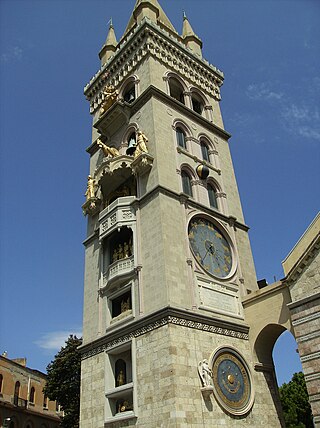
The astronomical clock of Messina is an astronomical clock constructed by the Ungerer Company of Strasbourg in 1933. It is built into the campanile of Messina Cathedral.

The stained glass windows of Chartres Cathedral are held to be one of the best-preserved and most complete set of medieval stained glass, notably celebrated for their colours, especially their cobalt blue. They cover 2600 square metres in total and consist of 172 bays illustrating biblical scenes, the lives of the saints and scenes from the life of trade guilds of the period.
The Bourges astronomical clock is an astronomical clock in Bourges Cathedral in Bourges, France.